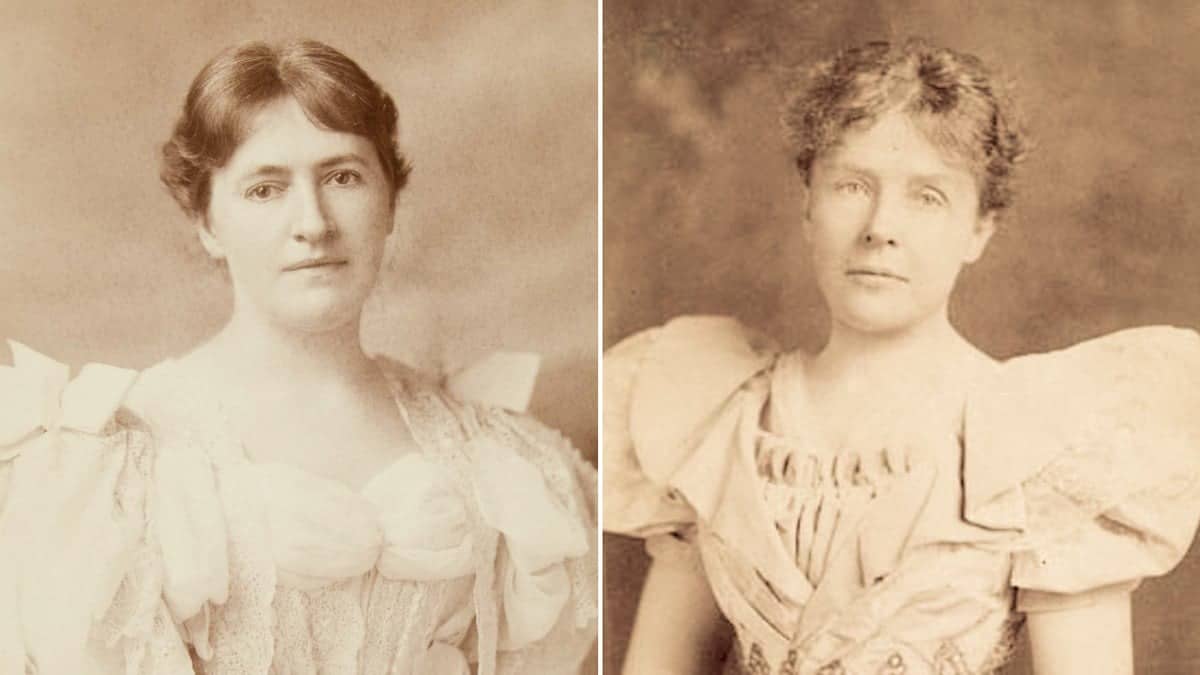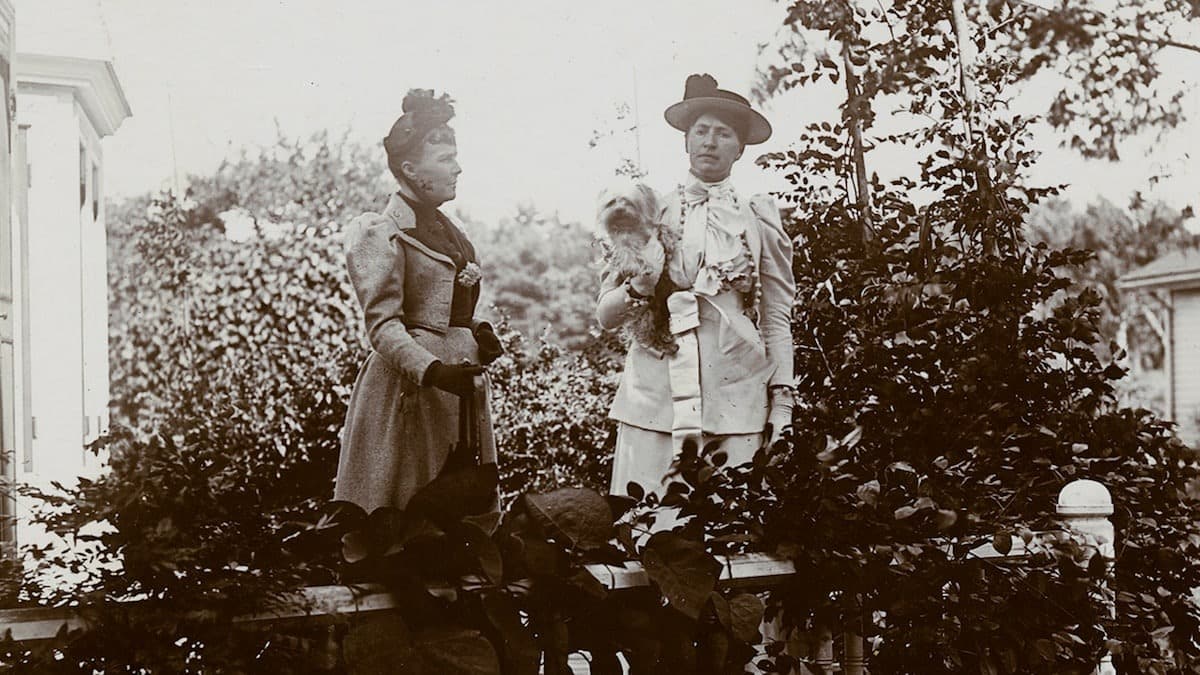Who Was America’s Lesbian First Lady? Here Are Her Love Letters And Same-Sex Love Story
In the summer of 1910, Evangeline Simpson Whipple embarked on a journey, leaving behind her Minnesota home under the care of her trusted steward. She left instructions for her caretaker: nothing was to be moved during her absence. Little did she know she would never return.
The wealthy widow set out on her travels, promising a swift return. Yet, fate had other plans, for she never again crossed the threshold of her beloved abode.
Her absence, however, was not devoid of significance, as it unveiled a trail of letters that would unravel the depth of her affection for Rose Cleveland, the dignified sister of President Grover Cleveland, the former First Lady of the United States, the former teacher at a women’s seminary, and the author of serious books (her book of essays, “George Eliot’s Poetry,” became a bestseller based on her fame).
The caretaker preserved those letters at Evangeline’s Minnesota home and they are collected in a new book, “Precious and Adored: The Love Letters of Rose Cleveland and Evangeline Simpson Whipple, 1890-1918.”
Their correspondence showed that their relationship transcended mere friendship. They revealed a love that defied the societal norms that had judgmental gazes toward same-sex relationships of their time.

Rose and Evangeline first met in the winter of 1889–1890, not long after Rose’s brother finished his first term as president. They likely met in Florida, where they both spent time with wealthy families.
Rose was 43 and unmarried, while Evangeline, probably 33, had inherited a fortune from her much older husband, who had passed away.
They started exchanging love letters in April 1890, after returning to their own homes. Evangeline lived in Massachusetts.
Rose writes:
“My Eve! Ah, how I love you! It paralyzes me … Oh Eve, Eve, surely you cannot realize what you are to me. What you must be. Yes, I dare it, now, I will not longer fear to claim you. You are mine by every sign in Earth & Heaven, by every sign in soul & spirit & body — and you cannot escape me. You must bear me all the way, Eve …”
Then, in May:
“You are mine, and I am yours, and we are one, and our lives are one henceforth, please God, who can alone separate us. I am bold to say this, to pray & to live to it. Am I too bold, Eve — tell me? … I shall go to bed, Eve — with your letters under my pillow.”
We only have Rose’s letters, so we don’t know much about how Evangeline replied. But sometimes, Rose quotes Evangeline’s letters in her own. For example, Evangeline wrote, “Oh darling, come to me this night — my Clevy, my Viking, My — Everything, Come! God Bless Thee.” Rose playfully responded, “Your Viking kisses you!”

Rose had trouble describing their relationship, saying, “I cannot find the words to talk about it,” and “the right word will not be spoken.” Back then, there wasn’t a word to describe a romantic relationship between women. While the word “lesbian” existed, it was mainly linked to the Greek poet Sappho.
Lizzie Ehrenhalt, co-editor of the book, explained, “This was before there was a concept of sexual orientation the way that we know it today.” It was during the 1890s, when Rose and Evangeline were exchanging letters, that the idea of sexual orientation was starting to be discussed, as sexology became a recognized field.
Women in that era often engaged in what was termed “romantic friendship,” which were close emotional and intellectual bonds, though not necessarily sexual, explained Ehrenhalt. This allowed wealthier white women, like Rose and Evangeline, to have intimate relationships without societal constraints.
Despite the term “romantic friendship,” Rose and Evangeline’s relationship went beyond mere emotional intimacy, according to Ehrenhalt. One letter speaks of “long rapturous embraces” that brought them immense joy and love.
They frequently requested to visit each other’s homes and exchanged affectionate nicknames like “Clevy” and “Wingie.” They also playfully referred to each other as “Granny” and “Granchile,” poking fun at their 10-year age difference. Rose, being older, called herself “Granchile,” while Evangeline, the younger of the two, was “Granny.”
Rose and Evangeline had a remarkable relationship that endured for many years. They traveled together to Europe and the Middle East and even bought property together in Florida. Their families were aware of their bond, and Rose expressed her love for Evangeline to her mother-in-law.

However, their story took a turn when Evangeline surprised everyone by announcing her engagement to Bishop Henry Whipple. Rose was deeply upset and pleaded with Evangeline to reconsider, even offering to leave everything behind for her.
Rose wrote:
“I do not think you need me now. But I plead that you will consider what I said this morning. I will give up all to you if you will try once more to be satisfied with me. Could you not take six months for that experiment? We would go away from everyone.”
Despite Rose’s efforts, Evangeline married the bishop.
Three weeks after the marriage of Evageline on Oct. 22, 1896, Rose went to Europe with a female friend. It’s not clear how close they were. Rose stayed in Europe for three years before returning.
Rose still sent letters to Evangeline, but they became less intimate. She stops calling Evangeline “Granny,” and instead of “Granchile,” she signs her letters with the more formal “R.E.C.” — Rose Elizabeth Cleveland.
But when the bishop passed away at his home in Minnesota on Sept. 16, 1901, Rose sent letters to Evangeline again and called her “Granny.”
In the following nine years, Rose and Evangeline’s letters changed. They became more tender and less passionate than before. Even though Evangeline stayed in Minnesota, they began visiting each other’s homes for longer periods again.
By 1909, Rose, who was in her mid-60s, grew weary of their back-and-forth visits. She expressed her longing for Evangeline, saying, “I need you, and life is too short to wait forever.”
The following year, Evangeline’s brother fell seriously ill while in Italy. Both she and Rose hurried to his side, sharing a cabin on the ship back across the Atlantic.
Even after his passing two years later, Rose and Evangeline continued to live together in the Tuscan village of Bagni di Lucca, now as true partners.
During World War I in 1914, they stayed in Bagni di Lucca and helped organize relief efforts, especially for refugees who arrived in Tuscany in 1917.
Then, the Spanish flu pandemic hit. While caring for a sick friend, Rose caught the virus and passed away on November 22, 1918, at the age of 72.
Devastated, Evangeline wrote to Bishop Whipple’s daughter, expressing her deep sorrow at the loss of Rose’s “noble and great soul.”
Evangeline lived on for 12 more years. She wrote a book about Tuscany and dedicated it to Rose. However, she passed away from pneumonia and kidney failure in London in 1930.
In 1969, a descendant of Bishop Whipple donated family papers to the Minnesota Historical Society. It’s unlikely she knew everything in those boxes. When the staff found the love letters, they suggested hiding them because they hinted at a romantic relationship between the two women.
However, in 1978, after complaints, the ban on the letters was lifted. While historians have mentioned the letters over the years, a complete collection was never published until Ehrenhalt and Tilly Laskey’s book.
Ehrenhalt noted, “There have been women loving other women for all periods of history,”
Rose Cleveland and Evangeline Simpson Whipple’s love story shines as a beacon of hope and defiance. Theirs is a testament to the enduring power of love, transcending barriers and leaving an indelible mark on the fabric of time.

